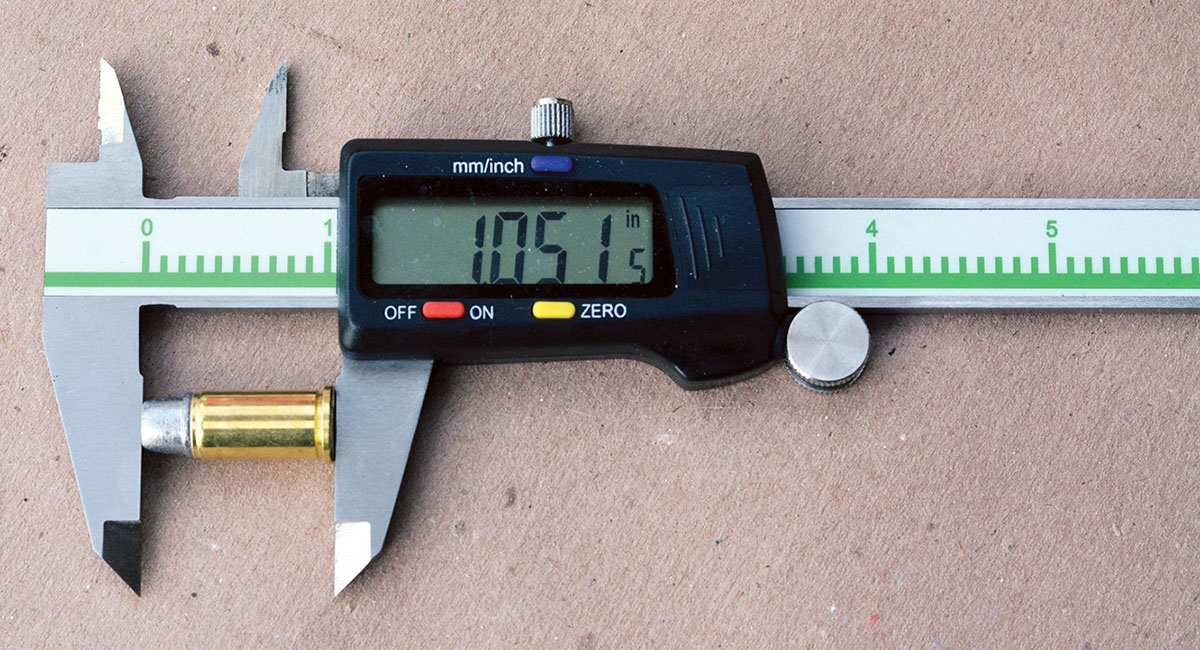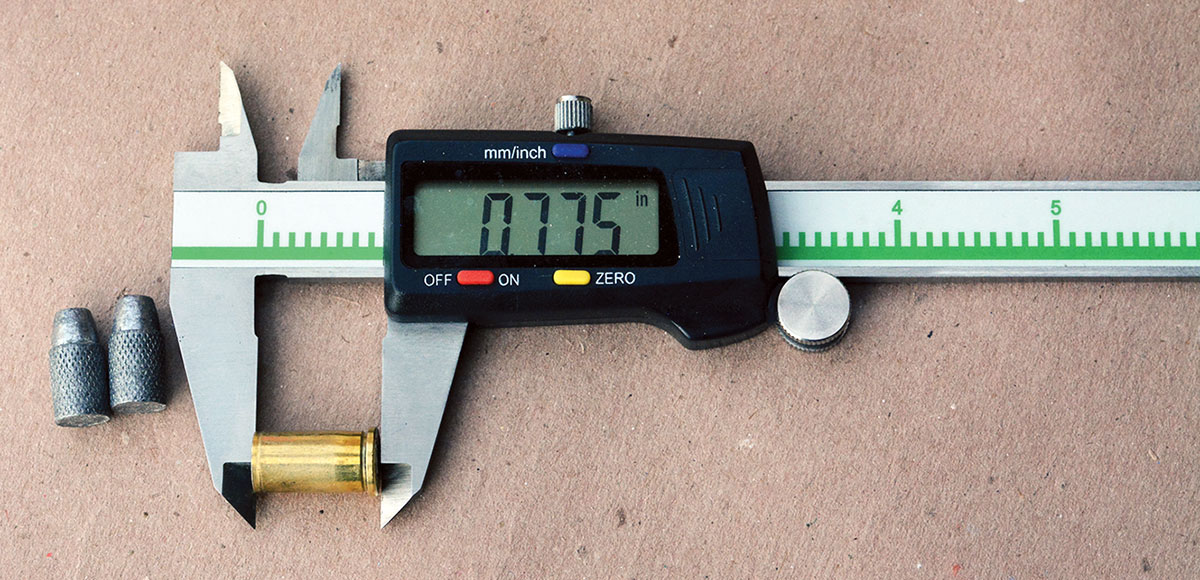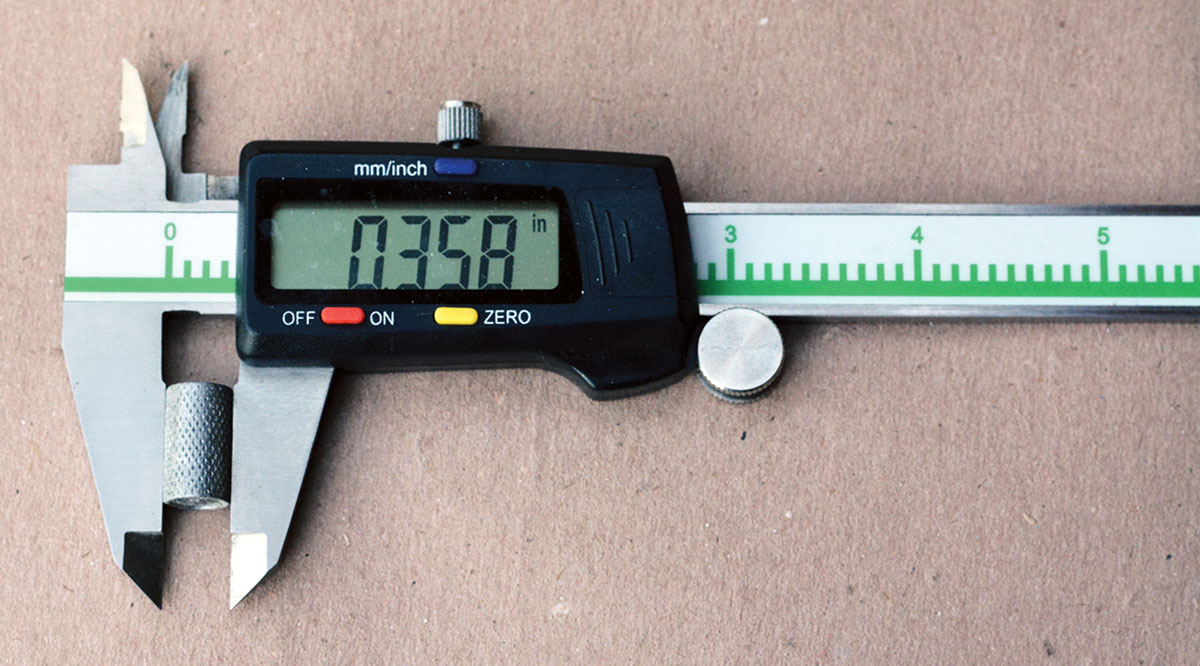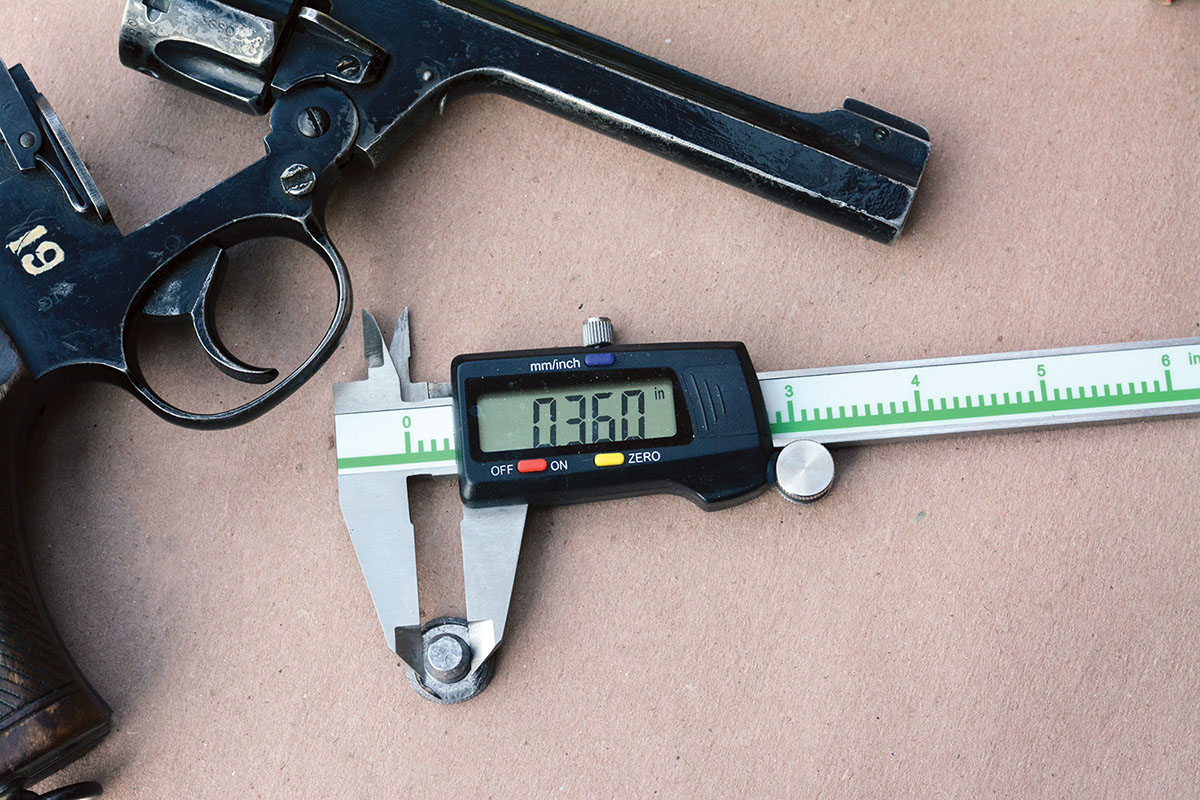
Brian used an Enfield No.2 Mk I chambered in 38 S&W to develop “Pet Loads” data.
The 38 Smith & Wesson (S&W) was developed between 1876 and 1877, naturally as a black-powder cartridge that contained around 14 grains of powder behind a 145-grain lead roundnose (RN) bullet. Most sources agree that the velocity was around 750 feet per second (fps) from revolvers fitted with 6-inch barrels.
Smith & Wesson first offered it in its highly successful top-break revolvers, which gained widespread popularity for personal defense but was especially popular in small-frame, double-action purse guns offered by S&W and competitors. It would seem that when the more potent 38 Smith & Wesson Special cartridge was developed in 1898, along with the more modern Hand Ejector double-action sixguns with swing-out cylinders, that it would soon replace the older .38 S&W cartridge, but that is only partially how it worked out.

Using modern propellants, the 38 S&W can deliver respectable performance while staying within industry pressure guidelines.
The 38 S&W is also known as 38 S&W Short, 9x20mmR, 38 S&W Super Police, 38 Colt New Police, 380 Rimmed, 380 Rim, 38-200, 380-200 and others. It features a larger bullet diameter than the familiar 38 S&W Special, as it measures .360-361 inch. Naturally, the case is also of larger diameter as it measures .3856-inch neck diameter and base diameter is .3863 inch. In rough numbers, this is around .006-008 inch larger diameter than the 38 S&W Special and as such, 38 Special cases cannot be trimmed to 38 S&W length to obtain cases to handload, or they often split on the first firing. The rim diameter is .440 inch, which is the same as the 38 S&W Special and 357 Magnum. The case length is .775 inch, while the maximum overall cartridge length is 1.240 inches.

The 38 S&W (left) is notably shorter than the 38 S&W Special (center) and 357 Magnum (right) and is loaded to lower pressures. Furthermore, it is not just a “short” version of the 38 Special, rather it is larger in diameter.
When the 38 S&W transitioned from black powder to smokeless around the turn of the century, it was loaded with 2 to 2.3 grains of Bullseye powder and velocities were listed at 670 fps to 730 fps with the same 145-grain lead bullet. Its popularity remained strong for many years, which was largely due to the many small top-break revolvers from companies such as Smith & Wesson, Iver Johnson and many other period purse guns. In some instances, these guns were produced until after World War II and it would take time for Smith & Wesson and Colt to offer truly modern compact double-action revolvers (such as the S&W Chief Special, Colt Detective Special and others) chambered for the 38 S&W Special, which served to help the 38 S&W retain reasonable popularity for many years.
Another notable chapter in the 38 S&W’s history occurred in 1922 when Britain elected to adopt it for military use in a scaled down version of its Webley top-break double-action revolver. In essence, they wanted a lighter gun and lighter ammunition. However, they developed a new load known as “.38-200” but it is also referenced as “.380-200.” As indicated, it used a 200-grain bluntnosed lead bullet pushed to around 600 fps, which was in production until 1957. But at some point, it was realized that the 200-grain load somewhat violated the Hague Conventions, as it was known to “expand or flatten easily in the human body.” In essence, the bullet would tumble after impact and offered unusual terminal effects. So another load known as “Cartridge, Pistol, .380 Mk II” or “.380 Mk IIz” was developed in 1937 that contained a 178-grain full metal jacket bullet (sometimes listed as 180 grains) that was pushed with 4 grains of cordite to around the same velocity.

The Enfield No.2 Mk I revolver features a top-break-style frame and action. However, it is stronger than small top-break U.S. produced black-powder era revolvers.

Buffalo Bore offers factory ammunition that serves to increase velocity while offering the effective performance associated with Keith-style SWC bullets.
Around 1929, the Western Cartridge Company introduced the “.38 S&W Super Police” load that contained a bullet similar to the British 38-200, as it featured a 200-grain lead bullet at between 610 and 630 fps depending on the source. Ultimately, the Western Cartridge Company produced loads for the British military that were primarily used for target work due to the previously mentioned Hague Conventions violations.

Many bullets will be seated with an overall cartridge length that is below industry standards, such as this Rim Rock 125-grain SWC at around 1.050 inches. However, the industry maximum cartridge length is 1.240 inches.
I don’t know when the last 38 S&W guns were produced, but Great Western Arms offered it in its derringers and Sturm, Ruger & Company produced the modern Speed-Six during the late 1970s for contract with the India government. There are reports that Ruger still manufactures guns for overseas sales (but that information has not been fully confirmed). Regardless, there is a huge variety of guns so chambered.

The 38 S&W has a maximum case length of .775 inch.
During my early teenage years, I wanted to shoot every gun that I could, as I thirsted for experience. During my freshman year of high school, a nickel-plated Smith & Wesson 38 Double Action 4th Model top-break was offered by a classmate at a reasonable price and it came with five boxes of factory-fresh ammunition. It was in high condition and shot reasonably well. Then, a friend offered an Enfield No.2 Mk I with mother-of-pearl stocks that was reported to have been owned by a famous British officer, which added no value in my mind and I gave him $35! I shot both guns and could easily watch the bullets in flight, but being a cowboy, outdoorsman and hunter, I sold them both to purchase more potent big-bore sixguns.
My next experience with the 38 S&W occurred during my senior year in high school when I was the civilian team member on a police PPC team. One of the police team members had access to a well-equipped machine shop and converted a Smith & Wesson Model 14 to 38 S&W, but he started with a 22 Long Rifle cylinder, shortened it to reduce bullet jump and increase accuracy potential and then chambered it to 38 S&W. Finally, he fit a match-grade bull barrel with competition sights. He hoped to gain an advantage over other competitors. However, he struggled to get speedloaders to work properly and switched back to his customized S&W Model 10 chambered in 38 Special for matches, but he traded the Model 14 to me. While it was less than perfect for competition, it was very accurate with groups measuring from 1 to 1.5 inches at 50 yards with select handloads along with my hand-cast bullets and the extreme spreads were almost always single digit. During the Thanksgiving turkey shoot, that sixgun put several turkeys in the trunk of my car before one of the match sponsors decided that I had won enough turkeys and suggested that I try my luck at the rifle range. In the years since, I have owned and fired several other guns chambered for 38 S&W, including Smith & Wesson Victory Model, Iver Johnson Hammerless, H&R Defender, Colt New Police and even a Great Western Arms derringer.

Most cast or lead bullets measuring .358 inch or larger will work in 38 S&W revolvers.
For today’s purposes, an Enfield No.2 Mk I was obtained that is in good condition with a good bore, etc. It featured a 4.975-inch barrel, but I am going to call it 5 inches and it’s a good representative revolver to develop handloading data.
As indicated, the 38 S&W utilizes bullets that are .360-361 inch. However, in working with K-frame Smith & Wesson Victory Models and Colt Police Positive revolvers so chambered, their barrel groove diameters slugged more or less identical to Smith & Wesson and Colt revolvers chambered in 38 Smith & Wesson Special that usually measure between .356 and .3575 inch. In other words, both Smith & Wesson and Colt used the same barrel stock for the 38 S&W and 38 S&W Special – at least when modern swing-out cylinder revolvers were developed. Also, in a Colt blueprint dated 1924, the groove diameter of all so-called .38-caliber cartridges is listed at .3585 inch. However, in slugging many Colt sixguns, their actual groove diameter is usually smaller than that figure at .356-357 inch. The point being is that many 38 S&W revolvers will work perfectly with standard 38 Special/357 Magnum bullets. The barrel of the Enfield No.2 Mk I slugged between .359-360-inch groove diameter. Regarding guns manufactured during the black-powder era, especially small-frame, top-break revolvers from Smith & Wesson and guns of similar design from different manufacturers; I have not slugged the barrel on those guns. However, due to their comparatively weak frames and locking system, along with being constructed of iron or mild steel, they are not suitable for the smokeless powder loads discussed herein today.

The Enfield No.2 Mk I revolver slugged .359-360-inch groove diameter.
For most of the post-World War II era, the 38 S&W has been listed by Remington and Winchester with a 146-grain lead RN bullet pushed to 685 fps. I only had around 20 rounds of the latter load on hand that clocked 661 fps from the test revolver. While those loads are still listed, their availability has been rather sporadic due to the huge demand for other cartridges in recent years. Buffalo Bore Ammunition currently offers a truly modern load that consists of a 125-grain Hard Cast FN listed at 1,050 fps and is designed for solid-frame guns and the Enfield No.2 Mk I. This is a semiwadcutter (SWC) profile bullet that serves to modernize the old 38 S&W. In checking the velocity, it clocked 935 fps from the Enfield, which has a rather generous barrel cylinder gap and is therefore expected to produce lower velocities when compared to modern Smith & Wesson and Colt revolvers with swing-out cylinders and tighter tolerances.
The Sporting Arms and Ammunition Manufacturers’ Institute (SAAMI) currently lists maximum average pressures at 13,000 CUP, with the accompanying data being within those limits. But again, smokeless-powder loads, either factory loaded or handloaded should not be used in any gun designed for black powder. However, most guns produced after 1900 will be suitable for smokeless-powder loads.

Swaged lead bullets from Hornady and Speer performed well.
To develop the accompanying data, new 38 S&W cases from Starline were used, which are readily available and can be ordered factory direct at (800) 280-6660. Naturally, they were full-length sized, inside chamfered and neck expanded prior to priming, charging with powder and seating bullets.
The 38 S&W has limited powder capacity, so it generally thrives on fast-burning powders such as Alliant Bullseye, Red Dot, Winchester 231, Accurate No. 2, Hodgdon Titegroup and similar propellants, but it also works very well with select medium-burn rate pistol and revolver powders such as Alliant Unique, Power Pistol, Ramshot True Blue and similar powders.
Powder manufacturers try very hard to minimize lot-to-lot variances, especially with canister-grade powders. For example, the average handloader develops a handload or utilizes data from a reloading manual and determines that is the perfect load. When the powder supply runs low, a new can is purchased and he/she needs to be able to load ammunition with the exact data and get more or less the same results. However, burn rate variations do exist from one lot number to the next of the same powder. This may not be a big deal when handloading for the 44 Magnum (although it can change results) but in the 38 S&W, it can change pressures and velocities enough that data needs to be adjusted. The point is to proceed with caution and pay special attention to velocities because if they are higher than they should be, pressures are probably higher as well. Watching for signs of excess pressure is very difficult with such a low-pressure cartridge. In other words, let’s say that a load is 10 percent or even 20 percent above maximum, that extra pressure will not manifest itself with excessively flattened primers, sticky case extraction and other common signs of a load with excess pressure. Again, checking velocities will prove especially valuable in developing handloads.

Most of the revolvers that the 38 S&W was chambered for were not known for great accuracy. However, accuracy was increased when loaded with hollowbase bullets such as the target on the right that was fired with Hornady 148-grain Hollow Base Wadcutter bullets.

The Hornady 148-grain Hollow Base Wadcutter bullets slug up to fill throats, prevent blow-by and increase accuracy.
Being a low-pressure cartridge with modest powder capacity, the 38 S&W will thrive on cast bullets, as they require notably less pressure to be reliably pushed down the barrel, avoid the dreaded bullet in the bore problem and achieve proper velocities. The suggested starting load powder charge weights should not be reduced or there becomes a risk of sticking bullets in the bore, which is potentially dangerous. Incidentally, the barrels of almost all 38 S&W revolvers were designed for cast or lead bullets. In essence, their barrels are made from relatively mild steels that will wear out prematurely when used in conjunction with jacketed bullets. A variety of swaged lead and cast bullets were used that ranged in weight from the Rim Rock 125-grain SWC (designed with the 38 S&W in mind) to the 199-grain roundnose from Lyman mould No. 358430 that serves to duplicate original British 38-200 loads. Bullets measuring .358 inch will generally work in most guns; however, guns with larger throats and groove diameter will benefit by using soft-swaged lead bullets with a hollow base, or size cast bullets to .360-361 inch. When using the larger diameter bullets, a larger diameter expanding ball measuring .356-357 inch should be considered. Also, special attention should be given to the overall cartridge lengths and bullet seating depth. For example, the Hornady 148-grain Hollow Base Wadcutter was seated with an overall cartridge length of 1.035 inches, which is not the traditional seating method for this bullet. Seating it deeper, or in the traditional method, will require a reduction in powder charges, or pressures will become too high. All bullets were roll-crimped to ensure that they stay in place, but also aids with proper powder ignition.

The 38 S&W thrives on fast- to medium-burn rate pistol and revolver powders.
A few loads containing jacketed bullets were also used; however, bullet weight was limited to comparatively light 110- and 125-grain versions to ensure that they could be pushed to high enough velocities to reliably exit the barrel. Examples include the 110-grain Speer Gold Dot HP and the Hornady 125-grain XTP-HP. Guns with severely pitted bores can benefit from loads containing jacketed bullets, at least from an accuracy standpoint. However, their velocities are still low enough that reliable expansion is questionable.
The 38 S&W is a historical cartridge that is rapidly approaching 150 years old and has been offered in a variety of quality and interesting guns. There is no reason to let them collect dust.














.jpg)
.jpg)


